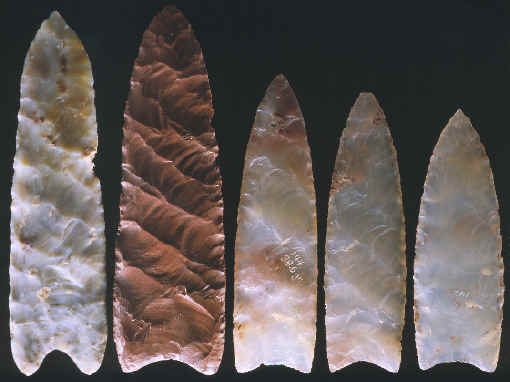|
||
|
To prove that Clovis technology originates in Siberia, and for that fact to be conclusively accepted, there must be a site that would date before Clovis. It would need to have a lithic technology based on both core blade and biface technology. The Aurignacian is basically a culture that used uniface stone tools made from blades. Clovis people were making very large bifacial knives, spears and bifacial cores over 12 inches (30.5cm) long. They had achieved a skill level of bifacial percussion flaking that had not been matched anywhere in the world at that time except for the Solutrean stone tool industry in Europe 3,000 years earlier. |
||
|
So far, it seems that the stone tool industry that comes nearest to Clovis is Europe's Solutrean. Paleo archaeologist Dennis Stanford says that "this technology is very, very close to the Clovis technology". One interesting trait that is similar is that both were burying caches of stone artifacts and covering them in red ochre. Another similarity is the edge-to-edge or "outre passe" bifacial percussion flaking both cultures were using to manufacture their points and knives. There are also some interesting projectile points in Spain's Solutrean that are in some ways similar to Paleo spear points in North America. |
||
|
A new theory has emerged to explain how Clovis people may have arrived in North America. Smithsonian archaeologist Dennis Stanford states that "it's clear to me, at least, that we are looking at multiple migrations through a very long time period-----that came in at different times". He believes there may be a good chance that Clovis people came from Europe from the east in boats. He says that not very many Paleo archaeologists are considering a connection with Paleo Indians having a maritime tradition. People were arriving in Australia in boats around 60,000 years ago so why not in North America? |
||
|
One thing is for certain, there have been no other stone tool industries anywhere else in the world that exactly duplicates Clovis. Dennis Stanford says "Clovis technology of North America is relatively unique in the world". He says he is also convinced that Clovis is a New World invention and that this particular style of lithic technology was developed by people already living in North America. |
||
|
"REFERENCES"
1988, "Encyclopedia of Human Evolution & Prehistory," by Ian
Tattersall, Eric Delson & John Van Couvering. |
||



